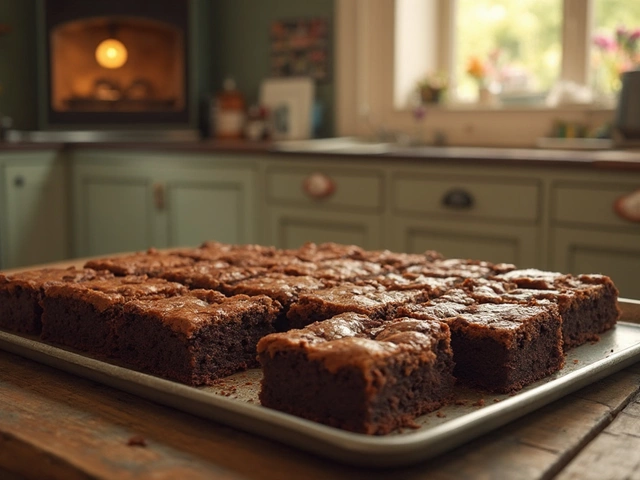Ever grabbed a batch of fresh cookies and wondered, 'What else can I use these for?' The thing is, cookies don’t have superpowers. Sure, they’re delicious, but they can’t just moonlight as anything you like. Don’t even think about tossing crumbled cookies into a stir-fry or using chocolate chip cookies as a stand-in for sandwich bread. You’ll just end up with a melted, mushy mess no one wants to eat.
It’s not just about flavor. The texture of most cookies falls apart fast when tossed somewhere they don’t belong. Try dropping leftover sugar cookies in a soup as a thickener and you’ll end up with a gluey, bland disaster. Bread works for French toast, but cookies turn sludge-like when dunked in egg and milk. Let’s get real: cookies just aren’t cut out to fix every kitchen problem you have.
- No-Go Uses in Cooking and Baking
- Why Cookies Don’t Replace Savory Staples
- Storage Pitfalls and Misuses
- Tips to Get More Out of Your Cookies
No-Go Uses in Cooking and Baking
Homemade cookies are a real treat, but let’s be honest—they have limits in the kitchen. One classic mistake is using cookies in recipes where they just don’t belong. Thinking of using cookie crumbs as a replacement for breadcrumbs? Don’t. Cookies are loaded with sugar and fat, so they burn faster and taste out of place in anything savory. Adding them to meatballs or casseroles doesn’t just make things sweet—it makes them weirdly soggy and greasy too.
Some folks get creative and crumble cookies on top of baked dishes instead of using the usual crispy topping. Problem is, cookies don’t brown and crisp up the same way as panko or regular bread. You’ll usually just end up with a sticky, melting layer, especially if your cookies have a lot of chocolate or icing.
Here’s a quick run-down of places you shouldn’t use cookies while cooking or baking:
- As a replacement for breadcrumbs (meatloaf, meats, or any crunchy topping)
- To thicken sauces or soups (they break down into a gritty paste)
- For French toast or savory bread puddings (they collapse and make a sweet, mushy mess)
- Mixed into savory batters or doughs (the flavors just clash—trust me, cheddar cookies are not a thing)
According to a 2024 survey of home bakers in the US, 78% said their first try at using cookies in place of savory ingredients ended in failure. Save yourself the trouble. If you still want to experiment, stick with recipes that actually call for cookies—like a cheesecake crust or a crumbled ice cream topping.
| Bad Cookie Use | What Happens |
|---|---|
| Breadcrumb replacement | Mushy, overly sweet, and greasy texture |
| Thickening agent | Grainy, gluey results—flavor goes downhill fast |
| French toast base | Turns to paste, no structure, sticks to pan |
| Crunchy casserole topping | Soggy and unevenly browned |
So, as tempting as it sounds to get creative with your homemade cookies, keep them where they shine: as dessert. Leave the savory swaps to bread and regular crumbs.
Why Cookies Don’t Replace Savory Staples
Homemade cookies just can’t stand in for bread, crackers, or other savory basics. Their sweetness, texture, and even the way they react to heat or moisture make them totally wrong for those jobs. Imagine swapping out hamburger buns for oatmeal cookies—sounds fun until you end up with sugary crumbs all over your hands and a flavor clash most folks wouldn’t enjoy. Cookies are simply not built for holding up sandwiches or soaking up soup.
Let’s look at the facts. Most cookies are loaded with sugar and sometimes chocolate or dried fruit; that’s a taste that just doesn’t fit a grilled cheese or turkey club. Their soft or crumbly texture falls apart with anything runny or steamy. Crackers, on the other hand, are dry, crisp, and purposely made with less fat and sugar to do their job right. If you need a savory crunch or a steady base, cookies will let you down every time.
"Cookies work because they’re dessert. When you try to use them in place of something like bread, the recipe just stops making sense—no one wants a peanut butter and jelly cookie sandwich." — Chef Erin Jeanne McDowell, baking expert and author
Here’s a quick side-by-side comparison:
| Food | Main Role | Texture | Flavor |
|---|---|---|---|
| Homemade cookies | Dessert/snack | Soft/crumbly/chewy | Sweet |
| Bread | Sandwich base | Firm/pliable | Savory or neutral |
| Crackers | Soup topper, crunch | Crispy/firm | Savory |
If you’re searching for a creative use for homemade cookies, think desserts—ice cream sandwiches or pie crusts—never main meals. Save the real savory stuff for roles where reliability actually matters. Otherwise, you’re setting yourself (and your dinner guests) up for some awkward bites and raised eyebrows.

Storage Pitfalls and Misuses
If you bake at home, you know how fast homemade cookies can lose their magic. People mess this up all the time, thinking cookies are more durable than they really are. Leaving cookies out in the open? They’ll go stale or mushy in less than two days, especially in humid weather. Trying to freeze cookies with super moist or creamy fillings? They’re likely to crack, get grainy, or lose their texture when thawed.
Airtight containers are great, but mix soft and crunchy cookies in one box, and they’ll all turn disappointingly soft. Storing cookies with strong flavors together—say, peanut butter and lemon—means everything ends up tasting the same. Ever crammed cookies in the fridge next to onions or leftovers? Cookies soak up smells like little edible sponges.
- Don’t use regular plastic wrap for frosted cookies—the topping will stick or get ruined.
- Glass jars look cute, but unless the seal is tight, your cookies won’t stay fresh for long.
- For freezing, wrap cookies individually and squeeze out air so freezer burn doesn’t creep in.
Now, here's a quick cheat sheet:
| Method | Best For | How Long Cookies Stay Good |
|---|---|---|
| Airtight tin | Most cookies (except soft/moist ones) | Up to 1 week |
| Freezer, well wrapped | Drop or bar cookies | 2-3 months |
| Glass jar (not airtight) | Crunchy cookies only | 2-3 days |
| Fridge | Messy fillings, cheesecake bars | 3-4 days |
The takeaway? Don’t treat cookies like bread or crackers. Every type wants different storage. If you mix up your storage, you risk soggy, chewy, or weirdly flavored disasters instead of treats you actually want to eat.
Tips to Get More Out of Your Cookies
Let’s be real—no one likes seeing homemade cookies go stale or get wasted. So here’s how to stretch the life (and fun) of that batch sitting on your counter.
- Homemade cookies stay fresher in an airtight container. Skip the fancy tins unless they seal tight. Plastic containers or zip-top bags work better for blocking out air.
- If your cookies lost their crunch, toss a slice of fresh bread in with them overnight. The cookies soak up the bread’s moisture and turn soft again. But don’t leave the bread too long, or you’ll end up with soggy cookies.
- Love ice cream? Sandwich a scoop between two cookies and wrap it up for an easy, crowd-pleasing dessert. Chocolate chip or oatmeal cookies both work really well for this.
- Crumble old cookies as a topping for yogurt, ice cream, or pudding. This isn’t just for show—the crunch and flavor upgrade dessert from average to awesome.
Thinking about freezing them? Here’s a quick look at how long cookies actually hold up in different situations:
| Storage Method | How Long Cookies Stay Fresh |
|---|---|
| Airtight Container (Room Temp) | Up to 7 days |
| Fridge | 2 weeks |
| Freezer | 3 months |
If you’re freezing, wrap each cookie in plastic wrap and then in foil, or just stash them in a zip-top freezer bag. Thaw on the counter for about 30 minutes and they’ll taste just-baked again.
Got a cookie pile but tired of eating them plain? Crush them into crumbs, then use as a pie crust for creamy desserts like cheesecake. The result: less waste and a tastier crust compared to store-bought.
One last tip—homemade cookies make stellar gifts. Wrap a small bundle in wax paper, tie with a string, and you’ve got a homemade treat people actually want. It’s a quick way to make someone’s day (or bribe a neighbor for a favor, just saying).





